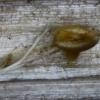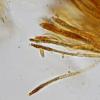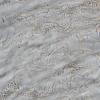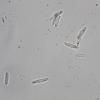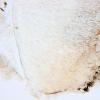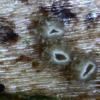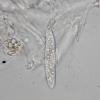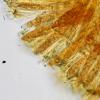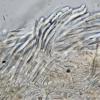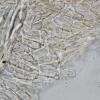
27-07-2022 17:08
 Harald Homa
Harald Homa
Hello dear friends of mushroom,on 11.06.2022 I fou

23-07-2022 02:14
James MitchellHello,Does anyone have access to an original 1958

29-07-2022 17:00
 Edvin Johannesen
Edvin Johannesen
Quick question, if I may: Are there several specie

28-07-2022 22:20
 Philipp Eschmann
Philipp Eschmann
GrüeziOn dead branches of Taxus baccata I found a

27-07-2022 22:36
 Philipp Eschmann
Philipp Eschmann
Grüezi I found this Orbilia on Viburnum lantana.

28-07-2022 11:34
Hello guys,I recently collected some strange possi
 Hello dear friends of mushroom,
Hello dear friends of mushroom,on 11.06.2022 I found the following fruiting bodies. I suspect it is Cyathicula starbaeckii, but I have not found a key and hardly any monographs, so I would like to ask here in the forum who can help me.
Fruiting body cup-shaped, long-stalked, on previous year's stem of Cirsium; young the stem is almost transparent; with age the fb turns completely to ochre with olive tinge; fruiting layer discoloured reddish brown in Baral's solution (dextrinoid?).
Margin with short hairs stuck together to form denticles, cream-coloured; marginal hairs in terminal phalanx with strongly light-refracting content; often discoloured (red)brown;
34.5x3.3 - 43.0x3.3
Paraphyses filamentous, (cylilndric), forked basally, terminal cell narrower below, thus slightly clubbed, with yellow, strongly light-refracting contents (apparently granulated), turning reddish brown like the apical cells of the hairs);
59.9x2.2-2.5 - 54.2x2.0
Asci 8-spored, clavate, J bb; hooks +
46.3x4.1 - 48.3x3.8 - 51.1x4.3
Spores long-ellipsoid to spindle-shaped, smooth, hyaline, with single, small to medium LB's, often oriented at the poles, slightly curved or kinked; , OCI=1
9.0-11.8 x 1.8-2.5 µm; MW(10): 10.7 x 2.1 µm
With kind regards
Harald

Amitiés Michel

thank you for the drawings and the key from Carpenter.
After the first look at the drawings, starbaeckii probably does not apply, as I did not find any crystals on the outside of the cup. In addition, the outer surface is covered with numerous coiled hairs, as you can see in the pictures. This is more like C. tomentosa, which would also fit the reddish-brown colouration of the marginal hairs.
Many thanks and best regards
Harald


Thank you for the information and the tip, it will take some time until I have worked out the comparisons. If I come to a plausible result, I will contact you.
Thank you and best regards
Harald

I found what I was looking for in Carpenter's key: the finding shown above corresponds to Crocicreas cyathoideum var. pteridicola (according to IF currently Cyathicula cyathoidea). So the tip is right on the mark - thank you very much.
The sticking point in the identification were the "hairs" or "free hyphal ends",
which are clearly visible under the microscope, but macroscopically do not lead to a felt-like appearance. They are filled with numerous golden yellow drops. Exactly this hint is in the key but is not found either in the monograph or in the drawing.
At the same time I worked on a second find, which grew on previous year's stems of Dryopteris carthusiana. Enclosed are the data and some pictures.
According to Carpenter's key it should be Crocicreas cyathoideum var. cyathoideum. In the IF, however, no actual name is given, which irritates me a bit.
But here are the facts:
Cup-shaped, stemmed fruiting bodies with almost closed margins; stem base dark brown, fading to ochre with an olive tone towards the top. The hairs on the excipulum and on the rim are white and slightly protruding in small clusters.
Diameter of FB: 123 - 225 µm, height: 229/171/185 µm
Asci clavate, crozier -, J bb, 8-spored, immature locally dextrinoid 42.8x7.1 u 45.3x6.1
Spores ellipsoid to slightly club-shaped, hyaline, unseptate, with several larger and some small LB´s (ochre to brownish); OCI: 2-3; size:10.6-13.3 x 2.1-3.0 µm, MW(8):12.0 x 2.5 µm
Paraphyses filamentous with numerous small LB´s; apically not dilated, only a few septa visible; 51.7x1.4-1.5
Marginal hairs or hyphae cylindrical, straight to slightly curved, some apically weakly flared, either very thick-walled or with light yellow-grey contents, hardly septate. 31.6x2.6 u 40.6x2.8 u 49.8x2.3
With kind regards
Harald


I hope I have made some progress in the meantime.
The following about the handling of substrates in the finds mentioned:
Index fungorum synonymises all varieties of Crocicreas cyathoideum under Cyathicula cyathoidea - how should I then differentiate?
Regarding the finding "C. starbeckii?" I have in the meantime done further research and found the documentation for Cyathicula cyathoidea on Ingo's site. This clarifies my question about the hyphal ends with the VBs, which first become colourless, then golden yellow and later brown (according to your hint!).
Regarding Carpenter's key, it should be noted that he places Crocicreas cyathoideum var. cyathoideum in the section under line 37*:
"37*. Apothecia usually on other substrates, occasionally on fern;"
But the hairs with the VB's were only under line 37, i.e. for Crocicreas cyathoidum var. pteridicola.
After all these hurdles I end up with Cyathicula cyathoidea in the sense of Crocicreas cyathoidea var. cyathoidea:
I have learned a lot and thank you very much for the info and patience!
Many greetings
Harald
p.s. Urceolella carestiana has been active in matching with the rest of my pictures!




